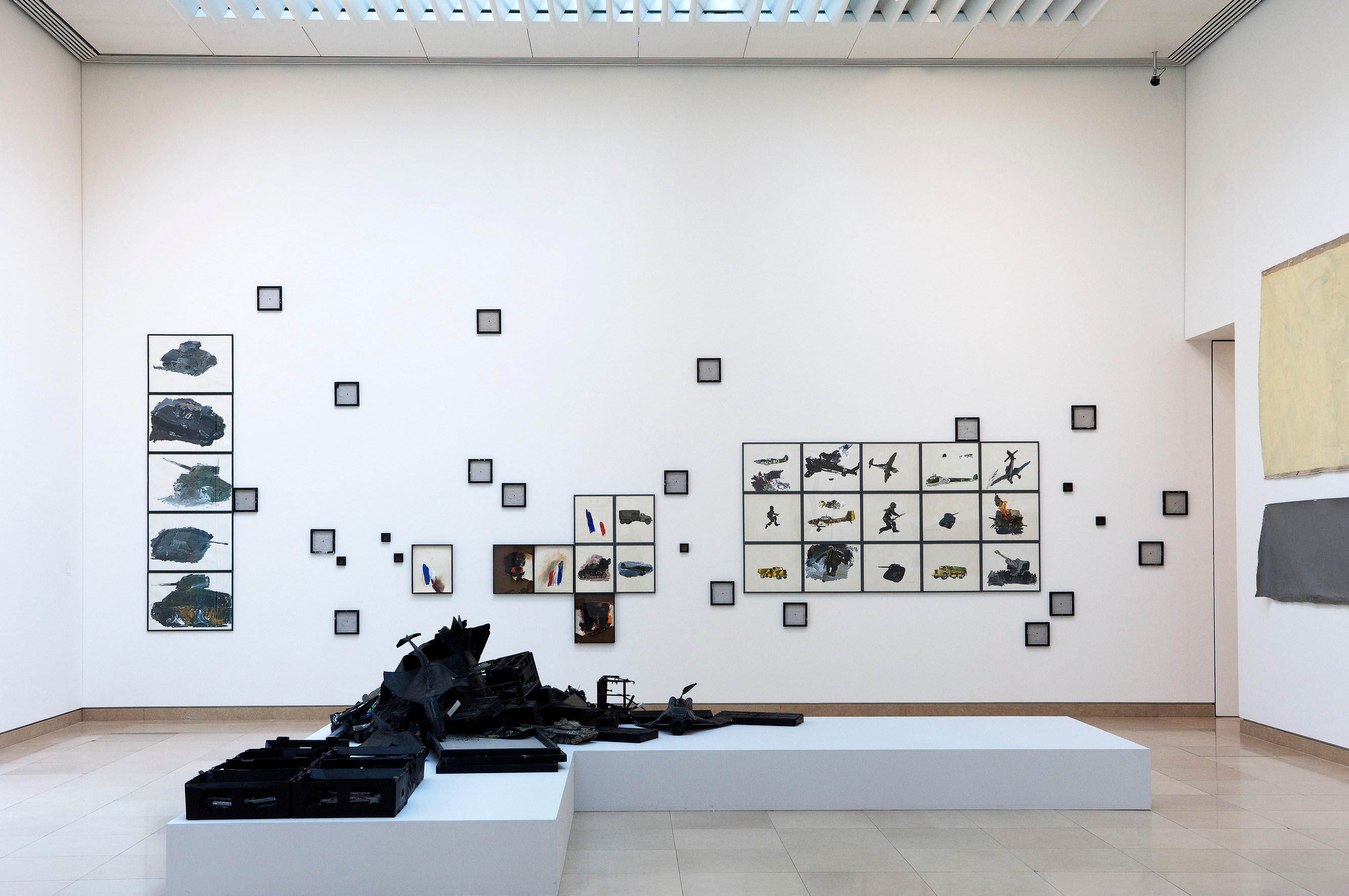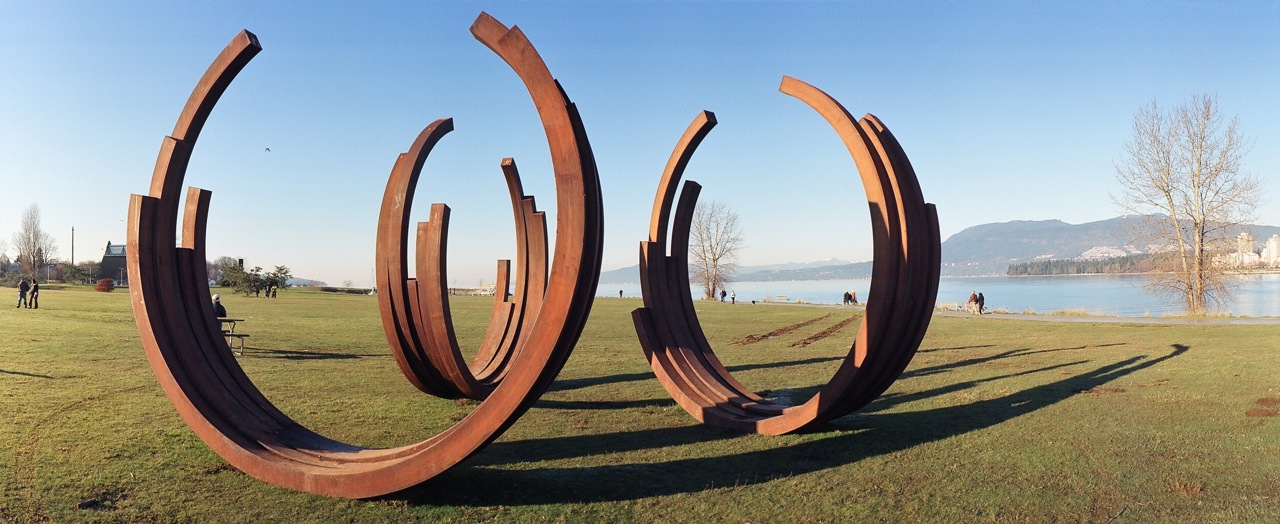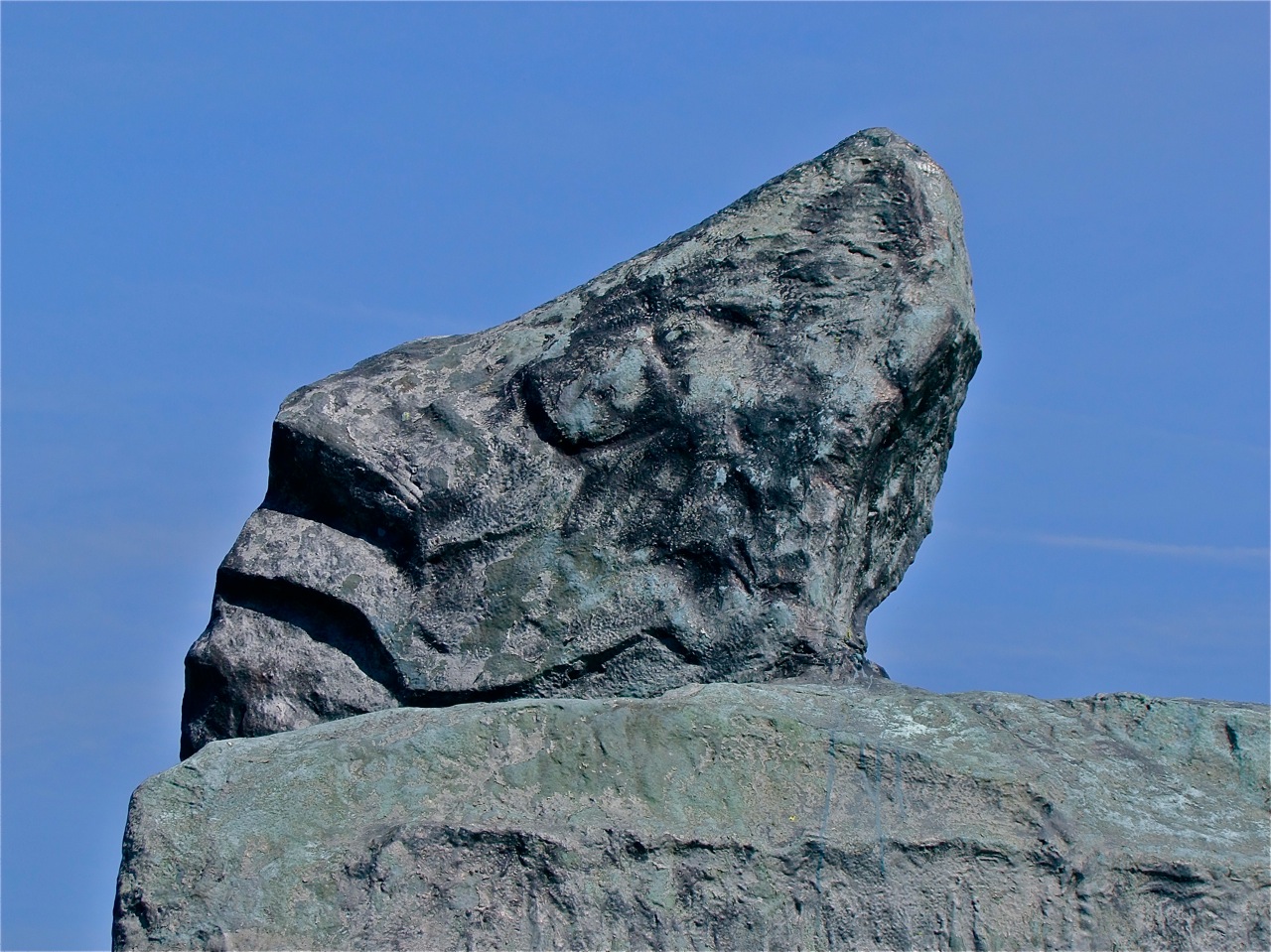It is well known that French influence on Art dropped after World War II. The main goal of this (short, lazy, though still ongoing) series of posts is to recall that, nevertheless, several good artists have grown up in France since then. Another one is to provide clues about a few puzzling points like: why are most of them so little known abroad ? All comments are welcome, as well as any suggestion.
Erwin Palmer's posts:- Gerard Gasiorowski, Etienne Martin, Paul Rebeyrolle: Lost in France (I)
- Is Bernar Venet one of the official artists of the French Republic ? (II)
- Outside Paris, once again (III)
- Where are the poets ? (IV)
-
Sanejouand's sculptures (V)

Gerard Gasiorowski, The Wall of War, 1974, as exhibited in the "Carre d'Art" (© D. Huguenin).
Nimes, September 2010.
Gerard Gasiorowski (1930-1986), Etienne Martin (1913-1995), Paul Rebeyrolle (1926-2005): Lost in France. Indeed, these three names are little known. To the extent that you will find little mention of the two formers in the US wikipedia, and only a three lines stub about the latter. Even in France, they are obviously not put on the front side. Of course, they all have their own page in the French wikipedia (Gasiorowski, Etienne Martin, Rebeyrolle) but, either in Paris or even if you are touring in France, going from a Centre d'Art Contemporain (Contemporary Arts Centers; you may find one in towns as small as Dijon or Saint-Etienne !) to a Musee des Beaux-Arts (Museum of Arts; most of them have a Contemporary Arts section), you need to be lucky to come across one of their masterpieces.
For Etienne Martin, a couple of practical reasons may be put forward. First, many of his sculptures, like Grand Couple (Large Couple, 1946) are made out of wood. So, you would not expect to find them in open air. Second, they are nice, attractive, but not showy. So, inside a museum, they are likely to be among those things you bump into when you step back to have a better glimpse at some large, flashy and colorful, painting. Rebeyrolle's case is more difficult to handle. His paintings, like Clonage II (2001), are expressionist ones. So, not the kind of work you can ignore when you walk through an exhibition !
However, Gasiorowski's case has to be the weirdest: he was in a famous gallery (Maeght Galleries, Paris); he got a first retrospective in the Museum of Modern Art of Paris, in 1983, three years before his sudden death, another, prestigious one, in the "Centre Pompidou", in 1995, ten years afterwards, and then it seems that he was more or less... forgotten. At least until this summer and a very nice exhibition held in the "Carre d'Art", in Nimes (France), which demonstrates how strong, rich, original, Gasiorowski's work has been. First, during six years (1965-1970), Gasiorowski was an hyper-realist, although not a standard one, as the atmosphere of the corresponding series of paintings, named l'Approche, has often a subtle, ambiguous and mysterious smell (like in l'Ouvreuse, 1965). Then, Gasiorowski switched to a kind of bad painting of his own, exploring in a long series of small and same size drawings (Les Croutes, 1970-1983, Les Regressions, 1973-1976) the favorite themes of naive art: landscapes, flowers, self-portraits (Tout n'allait pas pour le mieux, 1974)... Next, he started to play with these paintings like with pieces of a jigsaw puzzle. First, by putting them side by side in rectangular arrangements, he obtained the Amalgames (1971-1982). Within the frame of a more complex scheme, he created one of his masterpieces: Le Mur de la Guerre (The Wall of War, 1974; see above) whose elements are drawings of tanks, warplanes (like in Les regressions, III, 1973)... In 1976, Gasiorowski chose an original subject for the paintings of the students of his new, imaginary, academy, the Worosis Kiga (an anagram of his name) Academy (1976-1980): a hat. Ironically, the names of most students of this academy are well-known: Warhol, Lichtenstein, Johns, Oldenburg, Richter... Indeed, in Gasiorowski's work, humor is often around the corner like in the hilarious series of drawings l'artiste a l'hopital (the artist in the hospital, 1975-1976). See for instance artiste attendant sa nourriture (artist waiting for his food) or artiste ecoutant le diagnostic (artist listening to the diagnosis). However, Gasiorowski has obviously tried to take Painting as seriously as he could. He even managed to create a deity of Painting, called "Kiga", with her rituals and her people, who are depicted in a series of paintings made using as pigments his own feces (Les Jus, 1979). Lately, a few years before his death, he started a series of large paintings inspired by classic works of famous painters like Manet or Cezanne. See for instance Giotto. Atelier de Gasiorowski (Giotto. Gasiorowski's studio, 1984). So, as nicely demonstrated by this exhibition in Nimes, it is clear that it is difficult to grasp the meaning of Gasiorowski's work by simply looking at a single of his drawings picked at random. It is also obvious that his work is unlikely to remain for long as unknown abroad as it is nowadays.
Where to see them. Nearly one hundred drawings and paintings of Gasiorowski are shown in the Museum of Contemporary Art of Nimes (the "Carre d'Art") until October 10, 2010. If you happen to be around (Nimes is in the south of France, 75 miles west of Marseilles, three TGV hours south of Paris), do not miss such a rare (and rewarding) opportunity ! Rebeyrolle has his own Museum (the "Espace Paul Rebeyrolle"), but it is located nearby his birthplace, in Eymoutiers (30 miles east of Limoges) ! Etienne Martin is a little less hidden in the corners: until September 13 a dozen of his sculptures are shown in Beaubourg (the "Centre Pompidou", in Paris), while all year long fifteen of them are exhibited in the Museum of Modern Art of Paris (nearby the Trocadero).

Bernar Venet, 2006, Vanier Park, Vancouver
(by Flickr user Taz, CC BY 2.0)
Paris, October 2010.
Is Bernar Venet one of the official artists of the French Republic ? On may 31th, French President Nicolas Sarkozy was in Nice for the annual Africa-France summit. However, he took the time to inaugurate a large outdoor sculpture raised for celebrating the 150th Anniversary of the cession of Nice to France by Italy. This sculpture, called Neuf lignes obliques (Nine oblique lines), was designed by French artist Bernar Venet.
On September 18-19th, as part of the annual Journees du Patrimoine (National Heritage Days), the doors of the French Court of Audit, in Paris, were open to visitors, giving them the opportunity to admire the 30 meter long fresco painted by Bernar Venet on the ceiling of the gallery leading to the Grand'Chambre, for celebrating the 200th Anniversary of this venerable public institution.
From such facts, it is tempting to conclude that Bernar Venet stands among the major "official artists" of the French Republic.
However, it seems that in France things are rarely that clear cut. On the one hand, although there are many contemporary sculptures in Paris, and although several sculptures of Bernar Venet were exhibited in the Champ de Mars (nearby the Eiffel Tower) in 1994, to see one of them you need to go as far as La Defense, 6 miles away from Paris center. Moreover, among public museums, only Beaubourg is showing some of his works, but from time to time only and the more recent ones date back to the seventies, when Bernar Venet was a conceptual artist (see Representation graphique de la fonction, 1966), well before he (also) became a sculptor.
On the other hand, after Jeff Koons, Xavier Veilhan and Takashi Murakami, Bernar Venet is expected to be, next year, the fourth contemporary artist to exhibit at the Palace of Versailles.
So, after all, maybe this is what being an official artist means in France: when things become serious, people remember you. Otherwise, the playground is left open for others...

Jean-Michel Sanejouand, Peinture noir et blanc, 1988 (© Ludovic Sanejouand).
Nantes, April 2012.
Outside Paris, once again. Two summers ago (already), after visiting a nice retrospective of Gerard Gasiorowski in Nimes, I anticipated that "his work is unlikely to remain for long as unknown abroad as it is nowadays" (see above). I may well prove wrong. Indeed, although another exhibition of Gasiorowski's work is planned next summer, it will be held at Maeght Foundation, in Saint-Paul de Vance. Albeit a charming area (Saint-Paul de Vance is nearby Nice), it is for sure not expected to be on the way leading to international recognition, especially if the future of this exhibition happens to be the same as that of Nimes, namely: none. Noteworthy, although there are dozens of Contemporary Arts Centers in France it seems that, in year 2011, in spite of his widely acclaimed (in France) exhibition the previous summer, nobody there remembered Gasiorowski. Such an amazing lack of reactivity of the French milieu de l'Art could well provide a key clue for understanding why good French artists are so often ignored abroad.
Of course, one case is not enough. So, let us consider another one, analogous to Gasiorowski's in many respects. Incidentally, Jean-Michel Sanejouand is born in 1934, four years after Gasiorowski. He got his first retrospective in 1986, three years after Gasiorowski's first one, and yet another one ten years later, in Centre Pompidou, one year after Gasiorowski's own exhibition there (see Sanejouand's wiki page or his website). Now, almost two years after Gasiorowski's last retrospective in Nimes, Sanejouand's third retrospective is being held in Nantes (until the end of April; Nantes is two TGV hours west of Paris) and, likewise, it demonstrates how strong, rich, original, Sanejouand's work has been.
However, it also makes clear that following Sanejouand's work is demanding. First, because his style changes rather abruptly every five years or so but also because, within key periods, it has a clear tendency to drift, as if Sanejouand were continuously looking for more. For instance, his very first paintings (in 1978) look like rather naive landscapes, whose "spaces" (the series is called Espaces-Peintures; Spaces-Paintings) are "organized" by adding artificial elements, like in his previous series of works on actual places (Musee Galliera, 1968) or landscapes (Vesuvius, 1972). But, very soon (the same year, actually), explicit faces are being included, as if they were engraved in the mountains (29.06.78). Then, they start to become autonomous, both physically (their shape become distinct from the rest of the mountain; see 28.11.81) as well as graphically, the limit of each element of the painting becoming thicker, and more calligraphic, as if Sanejouand were trying to fuse his previous works on actual spaces and on more fantastic ones (see 1970). And yet this not enough since in the remaining of this single period faces turn into masks (18.10.84) and landscapes into a set of a few small trees sitting upon highly energetic calligraphic traces (01.03.85) while, in the next "period", color being given up (Peintures Noir et Blanc; Black-and-white Paintings), the large monochromatic "fields" are replaced by stony artifacts (19.10.89).
The following series, simply called Peintures (Paintings) is not so easy to connect with any of the previous ones. Although calligraphic traces are still there, they do not play any more the role of lines within a tortuous landscape. Moreover, the main subject of these Peintures is often a classic one: a fish (Comme un poisson; Like a fish, 1995), a few fruits (Danse, 1995), etc.
But maybe this is just the way Sanejouand had found for resisting to forces calling for a more radical move: forget about brushes and focus on sculpture ! As a matter of fact, Sanejouand's first works were kinds of sculptures made by gathering everyday life objects that are unlikely to meet (Fulmen, 1964). Now, Sanejouand's sculptures are made by putting together a few stones (which are, of course, unlikely to meet by themselves) so as to obtain, most of the time, rather anthropomorphic characters (Equilibre colle; Glued equilibrium, 2008). Note that these stones are always painted in black, in order to put the emphasis on their shape. Note also that Sanejouand's first sculptures (Le navigateur; The navigator, 1989) are quite similar to recent ones (Enigme; Enigma, 2010). Such an unusual lack of obvious drift, over his longer, still ongoing period, is likely to mean that, as far as Sculpture is concerned, Sanejouand does not feel any need to look for more. On the pictorial side, however, Sanejouand is still pursuing his exploratory activities. After painting his sculptures (Les deux amis; The two friends, 1997), he painted them within colorful landscapes (Diablerie; Devilment, 2003). Lately, he returned to black-and-white, focusing on the landscape itself, and, once again, on calligraphy (Untitled, 2009)...
I look forward to seeing what Sanejouand's next move will be. Although I hope to have the opportunity to discover that in a more prestigious place, it may well happen to be at Maeght Foundation, in the footsteps of Gasiorowski, once again...

Delacroix, Morocco sketchbook, 1832 (By wikimedia commons user Rama).
Paris, April 2013.
Where are the poets ? The golden age of French Art started in the middle of the nineteenth century, probably with the work of Delacroix. Interestingly, in his first text as an Art critics, in 1845, Charles Baudelaire gave his full support to Delacroix "the most original painter of ancient and modern times". Later on, in his poem Les phares (The Beacons), Delacroix is the only living artist mentioned:
Delacroix, lac de sang hanté des mauvais anges,
Ombragé par un bois de sapins toujours vert...
Guillaume Apollinaire, another great French poet, was a friend of many modern artists, noteworthy Braque and Picasso. As early as 1913, he wrote a famous essay entitled Les peintres cubistes (The cubist painters). More recently, in 1945, Fautrier's hostages were the subject of one of the very first texts of Francis Ponge as an Art critics, a few years only after the publication of his renowned masterpiece, Le parti pris des choses (The Voice of Things).
So, for over a century, French poets and artists used to know each other, and the words of the former seem to have been of help for the latter. Nowadays, the interest of French poets for visual arts seem to have decreased. And so did the interest of the rest of the world for French Art ?

Le Magicien, 2005, Rennes (by Flickr user Roel Wijnants, CC BY-NC 2.0)
Rennes, July 2014.
Sanejouand's sculptures.
How technically skilled do you need to be to make a sculpture that is worth looking at ? Like Michelangelo, do you need years to make a single of them ? More generally, what is the minimum amount of work required to turn raw materials into a sculpture ?
Among others, Picasso's answer was: not so much. To demonstrate this, he joined together the saddle and the handlebars of a bicycle and turned them into the Bull's Head (1942).
Like Picasso, many people have been playing with found objects. However, from the Sculptor's point of view, there are problems with manufactured ones: their shape is simple, often symmetric, and their surface texture is smooth, not to mention their color, which is usually uniform. So, no need to have a closer look at sculptures made with such objects: they are expected to be interesting only when seen at a distance. And no need to revolve around them as well: what you see from one side tells you enough about the way the other side looks like.
Sanejouand is also working with found objects. However, as a solution to the problems raised by manufactured ones, and maybe also because he is an inhabitant of the countryside, he chose to work with rough stones. And, indeed, as demonstrated in front of the railway station of Rennes by Le Magicien (The Magician, 1996), in Sanejouand's hands, a couple of stones joined together can become a sculpture.
However, Le Magicien is not a typical example of what Sanejouand's sculptures are about: like Le Silence (1989), his only other full-size sculpture, its anthropomorphic character is a bit too obvious. Indeed, although most, if not all, sculptures of Sanejouand seem to have their own personality (e.g. L'attente; Waiting, 2012), or to feature complex relationships between living beings (e.g. Boire a la source; Drinking at the source, 2010), most of them just look utterly alien (e.g. Incognito, 2008).
This is probably because Sanejouand makes no real effort to hide the stony character of his building blocks. As a consequence, when looking at a sculpture of Sanejouand, it is difficult to avoid the feeling that little is needed to give life to matter, in a stone or elsewhere. In any case, after looking carefully at Sanejouand's sculptures, you may well never look again at stones the same way !
Where to see them. Except the single large one in front of the railway station of Rennes (two TGV hours west of Paris) ? Nowhere. Although Sanejouand started his series of sculptures in 1989, 25 years later, to my knowledge, you can not see any other one in a public space.